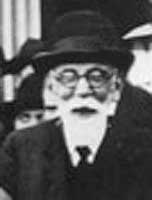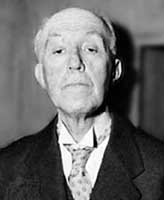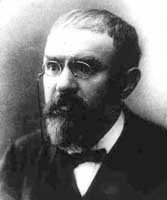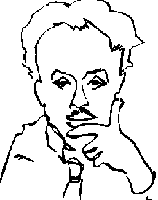Les grands mathématiciens et physiciens théoriques français et étrangers
|
Henri Poincaré
|
||
|
1854 - 1912 |
Jules Henri Poincaré
fut le plus grand homme de sciences de la fin du XIXè et du début
du XXè, le plus grand de France, cela ne fait pas de doutes, et
peut-être même du monde, même si, contrairement à
ses homologues allemands, notamment Hilbert, il ne laisse pas d'école
derrière lui. Mathématicien hors pair, touche à tout,
il est aussi connu des physiciens pour ses études sur la stabilité
du système solaire, mais aussi des cercles philosophiques pour
ses réflexions sur les fondements des sciences. 1881 est le début
d'une intense activité scientifique pour Poincaré. En 30
ans, il publie une trentaine de volumes, et près de 500 notes,
articles ou longs mémoires. Ses travaux changeront totalement le
paysage mathématique de son époque. Il crée notamment
de toutes pièces la théorie des fonctions fuchsiennes, révolutionne
l'étude des équations différentielles par ses études
qualitatives de solutions.
C'est en 1889 que le nom d'Henri Poincaré devient vraiment connu de tous. Il reçoit en effet le prix du roi Oscar pour un brillant mémoire sur le problème des 3 corps. Le roi Oscar est le roi de Norvège et de Suède, un passionné de mathématiques. Il décide d'offrir un prix de 2500 couronnes à une "découverte importante dans le domaine de l'analyse mathématique supérieure". Comme souvent en mathématiques, les erreurs sont fécondes, et celle-ci permit à Poincaré d'ouvrir la porte de la théorie du chaos. Poincaré était également un philosophe des sciences reconnu. Dans La Science et l'hypothèse, publié en 1902, il affirme le rôle essentiel du principe de récurrence. Plus tard, il interviendra dans la crise des fondements des mathématiques, s'opposant aux idées de Hilbert et de Russell. Le 28 juin 1909, il entre à l'Académie Française, privilège rare pour un scientifique. |
|
|
Before looking briefly at the many contributions that Poincaré made to mathematics and to other sciences, we should say a little about his way of thinking and working. He is considered as one of the great geniuses of all time and there are two very significant sources which study his thought processes. One is a lecture which Poincaré gave to l'Institut Général Psychologique in Paris in 1908 entitled Mathematical invention in which he looked at his own thought processes which led to his major mathematical discoveries. |
||
|
Marcel Brillouin
|
||
|
1854 - 1948
|
 |
en cours |
|
While in Melle, Marcel Brillouin read his grandfather's philosophy books. Brillouin was able to return to Paris in 1872 and, having spent the intervening time well, excelled at his studies. He entered the Ecole Normale Supérieure in 1874 graduating in 1878. Brillouin was a physics assistant at the College de France while he worked for his doctorate in mathematics and physics which was awarded in 1881. He then held posts as assistant professor of physics at Nancy, Dijon and Toulouse before returning to Paris to the Ecole Normale Supérieure in 1888. From 1900 to 1931 Brillouin was Professor of Mathematical Physics at the Collège de France. He was elected to the Académie des Sciences in 1921. Brillouin wrote over 200 papers on theory and experiment. The topics Brillouin wrote on were the kinetic theory of gases, viscosity, thermodynamics, melting conditions and electricity. Around 1900 he built a new model of the Eötvös balance. He wrote on Helmholtz flow and the stability of aircraft. An early worker on atomic structure he studied the Bohr (Niels Bohr) model of the atom. His results here were used by de Broglie and Schrödinger. Another topic which he worked on was the theory of the tides, a topic which he began to work on around 1925. In Brillouin is described as follows : - The interests of
this wide-ranging, open minded scientist extended from history of science
to the physics of the earth and the atom. |
||
|
Louis de Broglie
|
||
|
1892 - 1987 |
 |
Louis Victor Pierre Raymond , 7e duc de Broglie Prix Nobel de Physique en 1929. Le fait marquant : Le dualisme onde-corpuscule |
| Pour la suite de l'histoire cliquez sur le portrait | ||
|
à suivre
|
||

